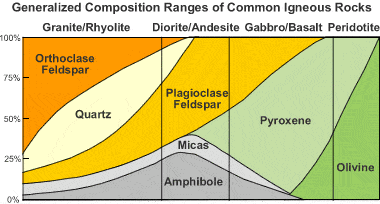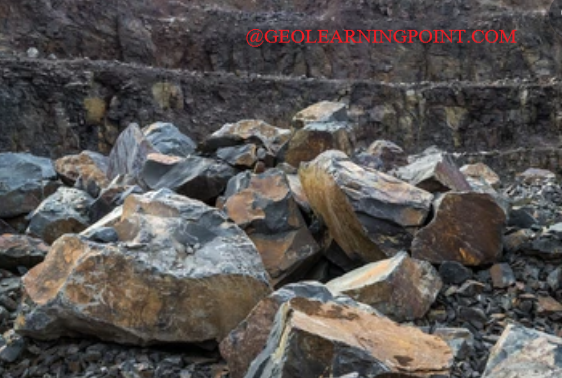What is Andesite?
Andesite is the name of a group of fine-grained, extrusive molten rocks that are typically light to dim dark in variety. They have a mineral structure that is transitional among stone and basalt. Andesite is a stone commonly found in volcanoes above joined plate limits among mainland and maritime plates.
An Extrusive Molten Rock
Andesite is normally found in magma streams created by stratovolcanoes above subduction zones. Since these magmas cooled quickly at the surface, they are for the most part made out of little gems. The mineral grains are normally little to such an extent that they shouldn't be visible plainly without the utilization of a hand focal point or other amplifying gadget.
A few examples that cooled quickly contain a lot of glass, while others that framed from gas-charged magmas have a vesicular or amygdaloidal surface.
Mineral Organization
Andesite frequently climates to different shades of brown. In the field, endured examples should be broken to see their variety and their mineral arrangement appropriately. Study hall examples generally don't need breakage.
 |
Igneous rock composition chart: This chart shows that andesite is typically composed of plagioclase, amphiboles, and micas; sometimes with minor amounts of pyroxenes, quartz, or orthoclase. |
Andesite is plentiful in plagioclase feldspar and amphibole minerals. Quartz and pyroxene minerals might be missing or present in little amounts. Modest quantities of mica will be available as biotite or muscovite. Andesite generally doesn't contain olivine. The going with graph named "Summed up Synthesis Scopes of Normal Volcanic Rocks" outlines the mineral arrangement of andesite.
Where Does Andesite Frame?
Andesite and diorite are normal rocks of the mainland outside above subduction zones. They by and large structure after a maritime plate liquefy during its plunge into the subduction zone to deliver a wellspring of magma.
 |
Stratovolcanoes: Pavlof Volcano (right) and Pavlof Sister Volcano (left) are a pair of symmetrical stratovolcanoes built of andesite flows and tephra on the Alaska Peninsula. Pavlof Volcano is one of the most active volcanoes in Alaska. Photo by T. Miller, United States Geological Survey. |
Diorite is a coarse-grained molten rock that structures when the magma stays underneath Earth's surface and cools gradually. Slow cooling works with the development of enormous mineral gems in the stone. Andesite is a fine-grained rock that structures when the magma emits onto the surface and solidifies rapidly.
Andesite and diorite have a creation that is middle of the road among basalt and rock. This is on the grounds that their parent magmas framed from the halfway softening of a basaltic maritime plate. This magma might have gotten a granitic commitment by liquefying granitic rocks as it rose or blended in with granitic magma.
The Topography of Andesite
Andesite gets its name from the Andes Heaps of South America. In the Andes it happens as magma streams interbedded with debris and tuff stores on the precarious flanks of stratovolcanoes. Andesite stratovolcanoes are likewise found above subduction zones in Focal America, Mexico, Washington, Oregon, the Aleutian Bend of Gold country, Japan, Indonesia, the Philippines, the Caribbean, and New Zealand, among different areas.
Andesite can likewise shape away from the subduction zone climate. For instance, it can shape at sea edges and maritime problem areas from halfway liquefying of basaltic rocks. It can likewise shape during emissions at mainland plate insides where profound source magma dissolves mainland outside layer or blends in with mainland magmas. There are numerous different conditions where andesite could shape.
Andesite Porphyry
At times, andesites contain huge, noticeable grains of plagioclase, amphibole, or pyroxene. These enormous precious stones are known as "phenocrysts." They start framing when a magma, which is cooling at profundity, moves toward the crystallization temperature of a portion of its minerals. These high-crystallization-temperature minerals start shaping underneath the surface and develop to noticeable sizes before the magma ejects.
At the point when the magma ejects onto the World's surface, the remainder of the dissolve solidifies rapidly. This creates a stone with two unique gem sizes: huge gems that shaped gradually at profundity (the "phenocrysts"), and little precious stones that framed rapidly at the surface (known as "groundmass").
"Andesite porphyry" is the name utilized for these stones with two gem sizes. The name of a plentiful phenocryst mineral might be utilized as a descriptive word to the stone name. A model is the hornblende andesite porphyry displayed in the going with photograph.
Broken down Gas and Unstable Emissions
A few magmas that produce hazardous emissions above subduction zones contain colossal measures of broken up gas. These magmas can contain a few percent broke down gas by weight! This gas can have a few starting points, instances of which incorporate the accompanying:
Water fume created when sea depths dregs on a maritime plate are warmed in a subduction zone.
Water fume created when hydrous minerals dry out in the intensity of a subduction zone.
Carbon dioxide created while rising magma experiences carbonate rocks, like limestone, marble, or dolomite.
Water fume created while a rising magma chamber experiences groundwater.
At profundity, these gases can be broken down in the magma like carbon dioxide disintegrated in a container of cold lager. In the event that that container of brew is shaken and out of nowhere decompressed by opening the can, the gas and the lager will eject from the opening.
A fountain of liquid magma acts likewise. A rising magma chamber can quickly be decompressed by a huge margin, blaming, or other occasion and a tremendous volume of quickly growing gas will detonate through the overlying stone.
Numerous volcanic tufts and debris ejections happen when gas-charged andesitic magmas emit. The gas pressure that causes the ejection blows a lot of minuscule stone and magma particles into the environment.
These particles, known as volcanic debris, can be blown high into the air and conveyed significant distances by the breeze. They frequently cause issues for airplane working downwind from the fountain of liquid magma.
Devastating ejections like Mount St. Helens, Pinatubo, Redoubt, and Novarupta were created by andesitic magmas with gigantic measures of broken up gas under high tension. It is challenging to envision how a magma can contain an adequate number of disintegrated gas to create one of these emissions. Magma is Earth's generally strong dissolvable.
 |
Andesite stone quarry in Carpathian mountains. Natural stone resources for constructing and building. |
The Slippery Meaning of Andesite
The proper meaning of andesite is risky. Many creators have ordered molten rocks in light of their synthetic and mineralogical structures. In any case, these characterizations are not generally in amazing understanding.
For a fine-grained rock like andesite, these groupings are difficult to utilize unequivocally when in the field or the study hall. They require synthetic or mineralogical examinations that are generally not accessible, reasonable, or pragmatic.
In the event that you look at a stone that gives off an impression of being andesite, however you are not sure that it meets the mineralogical or synthetic grouping of andesite, you could appropriately consider it an "andesitoid" rock. What's the significance here? It implies that the stone seems to be andesite, however, a tiny assessment or compound examination could disprove you!

